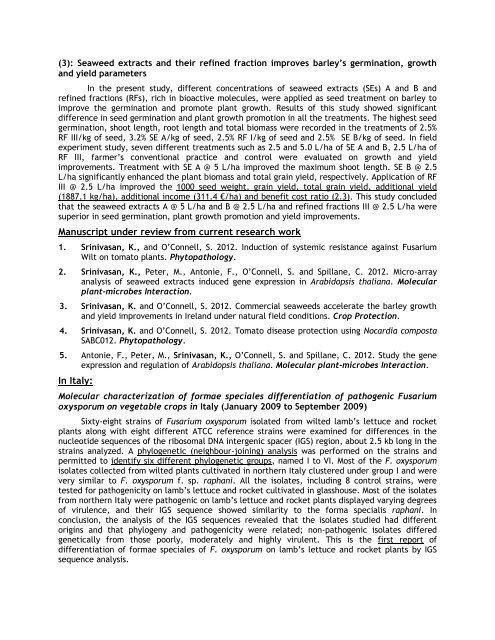CURRICULAM VITAE - Australasian Plant Pathology Society
CURRICULAM VITAE - Australasian Plant Pathology Society
CURRICULAM VITAE - Australasian Plant Pathology Society
You also want an ePaper? Increase the reach of your titles
YUMPU automatically turns print PDFs into web optimized ePapers that Google loves.
(3): Seaweed extracts and their refined fraction improves barley’s germination, growth<br />
and yield parameters<br />
In the present study, different concentrations of seaweed extracts (SEs) A and B and<br />
refined fractions (RFs), rich in bioactive molecules, were applied as seed treatment on barley to<br />
improve the germination and promote plant growth. Results of this study showed significant<br />
difference in seed germination and plant growth promotion in all the treatments. The highest seed<br />
germination, shoot length, root length and total biomass were recorded in the treatments of 2.5%<br />
RF III/kg of seed, 3.2% SE A/kg of seed, 2.5% RF I/kg of seed and 2.5% SE B/kg of seed. In field<br />
experiment study, seven different treatments such as 2.5 and 5.0 L/ha of SE A and B, 2.5 L/ha of<br />
RF III, farmer’s conventional practice and control were evaluated on growth and yield<br />
improvements. Treatment with SE A @ 5 L/ha improved the maximum shoot length. SE B @ 2.5<br />
L/ha significantly enhanced the plant biomass and total grain yield, respectively. Application of RF<br />
III @ 2.5 L/ha improved the 1000 seed weight, grain yield, total grain yield, additional yield<br />
(1887.1 kg/ha), additional income (311.4 €/ha) and benefit cost ratio (2.3). This study concluded<br />
that the seaweed extracts A @ 5 L/ha and B @ 2.5 L/ha and refined fractions III @ 2.5 L/ha were<br />
superior in seed germination, plant growth promotion and yield improvements.<br />
Manuscript under review from current research work<br />
1. Srinivasan, K., and O’Connell, S. 2012. Induction of systemic resistance against Fusarium<br />
Wilt on tomato plants. Phytopathology.<br />
2. Srinivasan, K., Peter, M., Antonie, F., O’Connell, S. and Spillane, C. 2012. Micro-array<br />
analysis of seaweed extracts induced gene expression in Arabidopsis thaliana. Molecular<br />
plant-microbes Interaction.<br />
3. Srinivasan, K. and O’Connell, S. 2012. Commercial seaweeds accelerate the barley growth<br />
and yield improvements in Ireland under natural field conditions. Crop Protection.<br />
4. Srinivasan, K. and O’Connell, S. 2012. Tomato disease protection using Nocardia composta<br />
SABC012. Phytopathology.<br />
5. Antonie, F., Peter, M., Srinivasan, K., O’Connell, S. and Spillane, C. 2012. Study the gene<br />
expression and regulation of Arabidopsis thaliana. Molecular plant-microbes Interaction.<br />
In Italy:<br />
Molecular characterization of formae speciales differentiation of pathogenic Fusarium<br />
oxysporum on vegetable crops in Italy (January 2009 to September 2009)<br />
Sixty-eight strains of Fusarium oxysporum isolated from wilted lamb’s lettuce and rocket<br />
plants along with eight different ATCC reference strains were examined for differences in the<br />
nucleotide sequences of the ribosomal DNA intergenic spacer (IGS) region, about 2.5 kb long in the<br />
strains analyzed. A phylogenetic (neighbour-joining) analysis was performed on the strains and<br />
permitted to identify six different phylogenetic groups, named I to VI. Most of the F. oxysporum<br />
isolates collected from wilted plants cultivated in northern Italy clustered under group I and were<br />
very similar to F. oxysporum f. sp. raphani. All the isolates, including 8 control strains, were<br />
tested for pathogenicity on lamb’s lettuce and rocket cultivated in glasshouse. Most of the isolates<br />
from northern Italy were pathogenic on lamb’s lettuce and rocket plants displayed varying degrees<br />
of virulence, and their IGS sequence showed similarity to the forma specialis raphani. In<br />
conclusion, the analysis of the IGS sequences revealed that the isolates studied had different<br />
origins and that phylogeny and pathogenicity were related; non-pathogenic isolates differed<br />
genetically from those poorly, moderately and highly virulent. This is the first report of<br />
differentiation of formae speciales of F. oxysporum on lamb’s lettuce and rocket plants by IGS<br />
sequence analysis.







![[Compatibility Mode].pdf](https://img.yumpu.com/27318716/1/190x135/compatibility-modepdf.jpg?quality=85)








